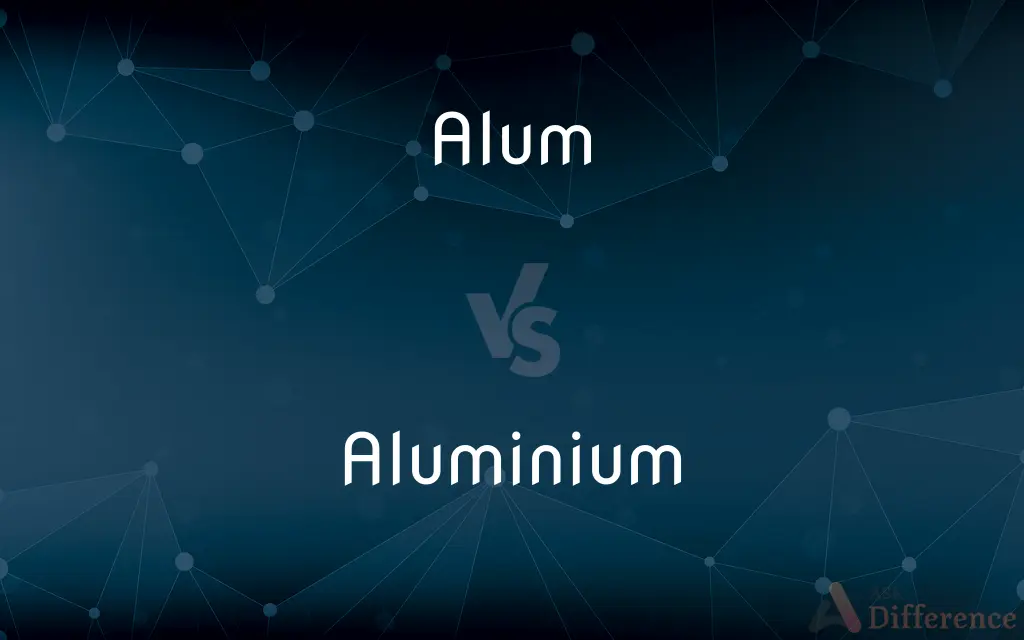Alum vs. Aluminium — What's the Difference?
Edited by Tayyaba Rehman — By Urooj Arif — Updated on March 28, 2024
Alum is a class of chemical compounds used for various purposes like water purification and in cosmetics, characterized by double sulfate salts of aluminum and another metal. Aluminium is lightweight, silver-white metallic element used in manufacturing.

Difference Between Alum and Aluminium
Table of Contents
ADVERTISEMENT
Key Differences
Alum primarily denotes a specific group of chemical compounds, known for their astringent and antiseptic properties. These compounds are typically double sulfate salts, combining aluminum with another metal, such as potassium, sodium, or ammonium. Aluminium, on the other hand, is a metallic element with the symbol Al and atomic number 13. It is renowned for its low density, resistance to corrosion (thanks to a protective oxide layer that forms on its surface), and its strength when alloyed with other metals.
Historically, alum has been used in dyeing processes, water treatment, and even in baking powder as a leavening agent. Its astringent properties make it a common ingredient in some deodorants and aftershaves. Aluminium's versatility makes it invaluable in industries such as aerospace, automotive, packaging, and construction. It is the most abundant metallic element in the Earth's crust but is always found combined in nature, primarily as bauxite ore from which it is extracted.
While alum contains aluminum as a component, the term "alum" encompasses a broader range of compounds and should not be confused with the elemental form, aluminium. The use and applications of alum and aluminium diverge significantly; alum is often found in specific industrial and cosmetic applications due to its chemical properties, whereas aluminium, as a structural metal, plays a crucial role in modern engineering and manufacturing.
The distinction between these terms highlights the difference between a class of chemical compounds and an elemental metal, each with unique properties and uses. Understanding these differences is essential for accurate communication in scientific, industrial, and commercial contexts.
Comparison Chart
Definition
A class of compounds with astringent properties.
A lightweight, silver-white metallic element.
ADVERTISEMENT
Composition
Double sulfate salts of aluminum and another metal.
Pure element with symbol Al and atomic number 13.
Uses
Water purification, cosmetics, dyeing.
Aerospace, automotive, packaging, construction.
Properties
Astringent, antiseptic.
Low density, corrosion-resistant, high strength when alloyed.
Occurrence
Synthesized from various minerals.
Found combined in nature, primarily as bauxite ore.
Industry
Chemical, cosmetic, water treatment.
Engineering, manufacturing, construction.
Key Difference
Specific compounds with aluminum and other metals.
Elemental metal used for its physical properties.
Compare with Definitions
Alum
A class of double sulfate salts.
Ammonium alum is utilized in textiles to fix dyes.
Aluminium
A lightweight, corrosion-resistant metal.
Aluminium is preferred for aircraft construction due to its strength-to-weight ratio.
Alum
Chemical compounds used in water treatment.
Potassium alum is used to purify water by coagulating impurities.
Aluminium
The most abundant metal in the Earth's crust.
Despite its abundance, aluminium is primarily obtained from bauxite ore.
Alum
Used historically in dyeing and leather tanning.
Alum was a crucial mordant in the dyeing industry for centuries.
Aluminium
Essential in the automotive industry.
Aluminium alloys are used in vehicles to reduce weight and improve fuel efficiency.
Alum
Can be a component in baking powder.
Alum powder sometimes acts as an acidulant in baking powder formulations.
Aluminium
Recyclable without loss of properties.
Aluminium cans are widely recycled, conserving energy and resources.
Alum
Found in deodorants for its astringent properties.
Crystal deodorants often contain alum to prevent bacterial growth.
Aluminium
Used in construction for its durability.
Aluminium frames are common in modern building designs for their longevity.
Alum
An alum () is a type of chemical compound, usually a hydrated double sulfate salt of aluminium with the general formula XAl(SO4)2·12H2O, where X is a monovalent cation such as potassium or ammonium. By itself, "alum" often refers to potassium alum, with the formula KAl(SO4)2·12H2O. Other alums are named after the monovalent ion, such as sodium alum and ammonium alum.
Aluminium
Variant of aluminum.
Alum
Any of various double sulfates of a trivalent metal such as aluminum, chromium, or iron and a univalent metal such as potassium or sodium, especially hydrous aluminum potassium sulfate, AlK(SO4)2·12H2O, widely used in industry as clarifiers, hardeners, and purifiers and medicinally as topical astringents and styptics.
Aluminium
A light, silvery metal extracted from bauxite, and a chemical element (symbol Al) with an atomic number of 13.
Alum
An alumna or alumnus.
Aluminium
(countable) A single atom of this element.
Alum
An astringent salt, usually occurring in the form of pale crystals, much used in the dyeing and tanning trade and in certain medicines, and now understood to be a double sulphate of potassium and aluminium (K2SO4·Al2(SO4)3·24H2O).
Aluminium
(slang) Aircraft or other machinery made partially or wholly of aluminium.
Alum
(chemistry) Any similar double sulphate in which either or both of the potassium and aluminium is wholly or partly replaced by other univalent or tervalent cations.
Aluminium
Same as aluminum, chiefly British in usage.
Alum
A past attendee or graduate (of either gender) of a college, university or other educational institution.
Aluminium
A silvery ductile metallic element found primarily in bauxite
Alum
(transitive) To steep in, or otherwise impregnate with, a solution of alum; to treat with alum.
Alum
A double sulphate formed of aluminium and some other element (esp. an alkali metal) or of aluminium. It has twenty-four molecules of water of crystallization.
Alum
To steep in, or otherwise impregnate with, a solution of alum; to treat with alum.
Alum
A white crystalline double sulfate of aluminum: the ammonium double sulfate of aluminum
Alum
A white crystalline double sulfate of aluminum: the potassium double sulfate of aluminum
Alum
A person who has received a degree from a school (high school or college or university)
Alum
A double sulphate of aluminum and potassium that is used as an astringent (among other things)
Common Curiosities
What is alum used for?
Alum is used for water purification, in cosmetics as an astringent, in dyeing fabrics, and sometimes in food processing.
Can alum be found in nature?
While alum can be synthesized from minerals, natural occurrences are rare, and it is mainly produced for specific applications.
Are there environmental concerns with aluminium production?
Yes, aluminium production is energy-intensive and can have significant environmental impacts, though recycling aluminium is highly efficient and lessens these effects.
What role does alum play in water treatment?
Alum is used as a coagulant in water treatment processes to remove impurities and clarify water.
How does alum differ from aluminium?
Alum refers to compounds containing aluminum and other metals, used for specific chemical properties, while aluminium is the elemental metal used primarily for its physical properties.
Why is aluminium important in construction?
Its durability, light weight, and resistance to corrosion make aluminium ideal for construction, especially in frames and facades.
What is aluminium?
Aluminium is a metallic element known for its low density, high strength when alloyed, and resistance to corrosion.
Is alum safe to use in cosmetics?
Alum is considered safe for use in certain cosmetics, like deodorants, due to its antiseptic and astringent properties, but usage should be mindful of potential skin sensitivities.
How is aluminium obtained?
Aluminium is extracted from bauxite ore through a process involving crushing, refining, and smelting, which separates pure aluminium metal.
How has the use of aluminium changed over time?
Initially rare and precious, technological advances in aluminium extraction have made it ubiquitous in various industries, from packaging to aerospace.
Share Your Discovery

Previous Comparison
Seltzer vs. Spritzer
Next Comparison
Advection vs. ConvectionAuthor Spotlight
Written by
Urooj ArifUrooj is a skilled content writer at Ask Difference, known for her exceptional ability to simplify complex topics into engaging and informative content. With a passion for research and a flair for clear, concise writing, she consistently delivers articles that resonate with our diverse audience.
Edited by
Tayyaba RehmanTayyaba Rehman is a distinguished writer, currently serving as a primary contributor to askdifference.com. As a researcher in semantics and etymology, Tayyaba's passion for the complexity of languages and their distinctions has found a perfect home on the platform. Tayyaba delves into the intricacies of language, distinguishing between commonly confused words and phrases, thereby providing clarity for readers worldwide.














































